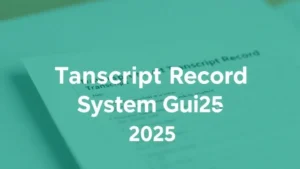High School Transcript: Complete Guide 2025
Meta Description: Understanding high school transcripts: what they include, how to get them, and why they matter for college applications.
You’ve worked hard for your grades, right? Now your high school transcript stands between you and your dream college. In fact, as of 2025, more universities like those in the University of California system weigh transcripts heavily since many schools have gone test-optional[2]. Agree? You probably are curious about what’s on that piece of paper—and how to get it without a hitch.
Here’s the promise: by the end of this guide, you’ll know exactly what’s on your transcript, why it matters, and how to order it fast—whether you need a paper copy or an electronic submission. You’ll also get pro tips to avoid delays (and that awkward follow-up email). Simple. Effective. Done right.
Ready? Let’s dive in.
Table of Contents
What Is a High School Transcript?
Hook: Ever wondered why colleges ask for this official record instead of just your diploma?
Context: In other words, your high school transcript is the complete academic record of courses you took, grades earned, credits accumulated and your GPA. It’s more than a receipt—it’s a snapshot of your high school career.
Detailed Explanation:
- Course History: Lists every class taken from freshman to senior year.
- Grades & Credits: Shows letter grades and credit hours earned.
- GPA Calculation: Weighted vs. unweighted GPA, plus class rank (if applicable).
- Honors & AP Labels: Marks advanced courses that boost your profile.
Here’s a quick peek at the main components:
- Personal Info (name, DOB)
- School Info (CEEB code, district)
- Academic Record
- GPA & class rank
- Graduation date
Why It Matters: Colleges use this to verify your academic rigor over four years. Employers might glance at it to confirm your education. It’s your official story—warts and all.
Why Your Transcript Matters More Than Ever
Hook: Test scores optional? Your transcript just got a promotion.
Context: With many schools moving to test-optional admissions, admissions officers lean on transcripts to assess grit, creativity and leadership[2]. The truth is, your grades tell a story about your study habits and academic growth.
“High school transcripts, as well as activities and essays, provide enough information to assess qualities such as grit, creativity and leadership.” – Youlonda Copeland-Morgan, UCLA Vice Provost[2]
Real Example: Jane applied to NYU without SAT scores. Her strong AP Physics and English grades, plus 4.0 GPA, sealed the deal.
Actionable Takeaway: Review your transcript’s course rigor. If something’s missing, ask your counselor about adding an honors designation.
How to Get a High School Transcript
Hook: Time is ticking—college deadlines are looming.
Context: You might be asking “What is the fastest way to get my transcript?” or “How long does it take?” The process varies by state and district, but most schools offer both paper and electronic options.
Step-by-Step:
- Verify Personal Info – Match your name, DOB, and SSN exactly.
- Fill Out Request Form – Many districts post forms online. Look for “transcript request”.
- Choose Delivery Method – Paper by mail or secure electronic submission (e.g., Parchment, FASTER in FL).
- Pay Fees if Required – Some schools charge a small processing fee.
- Follow Up – Confirm delivery 7–10 business days later.
Example: In Texas, you can request via TEA-approved portal or mail. Electronic systems often deliver within 48 hours[1].
Actionable Takeaway: Set a calendar reminder to request your transcript at least 3 weeks before deadlines.
Decoding Your Transcript: Grades, GPA & Credits
Hook: Numbers can be confusing. Let’s break them down.
Context: Knowing how your GPA is calculated and what credits count can help you explain any irregularities in your application.
Detailed Explanation: Most schools report both unweighted (4.0 scale) and weighted GPAs. Honors and AP classes often add 0.5–1.0 bonus points. Here’s how it works:
- A = 4.0 (unweighted) or 5.0 (AP/honors weighted)
- B = 3.0 / 4.0
- C = 2.0 / 3.0
- Credit hours reflect course length (e.g., 0.5 for semester-long).
You might be wondering why some courses don’t boost your GPA. That’s because only designated advanced classes receive weight. Talk to your counselor to see which courses qualify.
Internal Resource: Check out School Transcript Guide for Students 2025 for a deeper dive into weighted vs. unweighted scales.
Actionable Takeaway: Review your GPA section carefully. If you spot an error, request a correction from your registrar ASAP.
Electronic vs. Paper Transcripts
Hook: Which one wins: email or snail mail?
Context: Electronic transcript systems like Parchment or FASTER deliver transcripts fast, securely, and with tracking. But paper copies still have their place, especially for scholarship applications or local internships.
Comparison:
| Feature | Electronic | Paper |
|---|---|---|
| Speed | 24–72 hrs | 5–10 business days |
| Security | Encrypted, tracked | Risk of loss in mail |
| Cost | $0–$5 | $2–$10 |
| Acceptance | Most colleges | Certain employers |
Actionable Takeaway: Choose electronic submission whenever possible. If a paper copy is required, request extra copies and keep one on file.
Common Mistakes & Pro Tips
Hook: Small missteps can cause big headaches.
Pro Tips:
- Verify your name spelling—no nicknames allowed.
- Confirm your school’s CEEB code for college portals.
- Save PDF backups of every transcript request confirmation.
- Use a personal email—not your school account—to avoid blocked attachments.
Common Mistakes:
- Forgetting to pay request fees.
- Using outdated school forms.
- Missing deadlines for early decision.
Future Trends in Transcript Management
Hook: What’s next for your academic record?
Context: Education agencies are releasing more transparent performance data and adopting blockchain pilot programs to secure records. Expect mobile-friendly portals and real-time updates on courses and grades.
“With the release of the 2025 A–F Ratings, we are reinforcing our commitment to transparency and to providing accurate, readily available information that helps every family understand how their school is doing.” – Mike Morath, Texas Education Commissioner[1]
Actionable Takeaway: Stay informed about new electronic transcript platforms—your future employer might ask you to share a blockchain-verified copy.
Frequently Asked Questions
- How long does it take to get a high school transcript?
- Electronic: 24–72 hours. Paper: 5–10 business days, depending on your school.
- Can I request my transcript online?
- Most districts provide online portals like Parchment. Check your counselor’s website for a request link.
- What’s the difference between a transcript and a diploma?
- A diploma certifies graduation; a transcript details your courses and grades.
Conclusion
Getting and understanding your high school transcript doesn’t have to be daunting. We’ve defined what it is, explored its growing importance in 2025, and walked through how to request both paper and digital copies. You’ve also learned to decode GPA, avoid common mistakes, and peek into the future of transcript tech.
Now, here’s what to do next:
- Review your current transcript for accuracy.
- Request official copies at least three weeks before deadlines.
- Store digital backups in a secure cloud folder.
Your transcript is your academic fingerprint—own it, master it, and let it open doors. Good luck!





